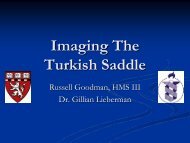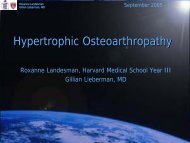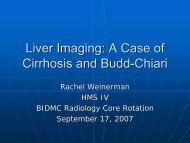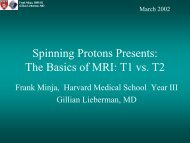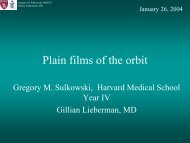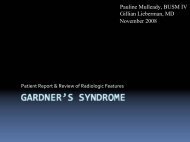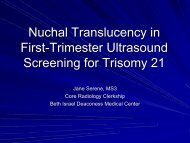Orbital Lymphoma - Lieberman's eRadiology Learning Sites
Orbital Lymphoma - Lieberman's eRadiology Learning Sites
Orbital Lymphoma - Lieberman's eRadiology Learning Sites
Create successful ePaper yourself
Turn your PDF publications into a flip-book with our unique Google optimized e-Paper software.
Ranbir Singh Sandhu<br />
Gillian Lieberman, MD<br />
<strong>Orbital</strong> <strong>Lymphoma</strong><br />
Ranbir Singh Sandhu,<br />
University College London Medical School<br />
Gillian Lieberman MD, BIDMC<br />
1
Ranbir Singh Sandhu<br />
Gillian Lieberman, MD<br />
Our Patient – Clinical Picture<br />
• This topic will be presented in the context of<br />
our patient.<br />
• She is a 71 year old female who presented with<br />
gradual painless right sided proptosis.<br />
www.diagnosticdigest.com<br />
2
Ranbir Singh Sandhu<br />
Gillian Lieberman, MD<br />
Imaging Options for the Orbits<br />
To image the orbit, we can use:<br />
• Plain Film<br />
• Its main use is screening for metallic foreign bodies.<br />
• Ultrasound<br />
• It is used to characterize abnormalities (e.g., masses).<br />
• CT<br />
• For further characterization of abnormalities and bone detail (e.g.,<br />
abnormal bone mineralization).<br />
• MRI<br />
• It is chosen for its enhanced soft tissue contrast.<br />
• Angiogram<br />
• It identifies aberrant blood vessels such as those created by<br />
tumors (not routinely used).<br />
3
Ranbir Singh Sandhu<br />
Gillian Lieberman, MD<br />
Our Patient’s CT Scan of Orbits<br />
(with contrast)<br />
• Marked<br />
displacement of the<br />
globe anteriorly.<br />
• A lateral mass,<br />
hyperdense to fat,<br />
is present in the<br />
right orbit:<br />
• It is homogeneous<br />
in its composition.<br />
• It measures 4x2cm.<br />
• It has intra-conal<br />
and extra-conal<br />
components.<br />
• There is no evident<br />
local bone erosion.<br />
PACS, BIDMC (Axial CT scan, C+ (with contrast))<br />
4
Ranbir Singh Sandhu<br />
Gillian Lieberman, MD<br />
Our Patient’s CT Scan of Orbits<br />
(with contrast)<br />
• The right lateral rectus<br />
muscle is not seen. The<br />
mass is either displacing,<br />
encasing or expanding it.<br />
A coronal view would aid<br />
its identification.<br />
• There is no remodelling<br />
or indenting of the globe<br />
contour.<br />
• There is no reticulation of<br />
retro-bulbar fat (unlike<br />
that seen with<br />
pseudotumor).<br />
Retro-bulbar Fat<br />
PACS, BIDMC (Axial CT scan, C+)<br />
5
Ranbir Singh Sandhu<br />
Gillian Lieberman, MD<br />
Our Patient’s CT Scan of Orbits<br />
(with contrast)<br />
• This is the level of<br />
the superior aspect<br />
of the orbit.<br />
• There is still no<br />
evident bone<br />
erosion.<br />
• Right lacrimal gland<br />
involvement is likely<br />
since it is not<br />
visualized in the<br />
right orbit unlike in<br />
the left orbit.<br />
Left Lacrimal<br />
Gland<br />
PACS, BIDMC (Axial CT scan, C+)<br />
6
Ranbir Singh Sandhu<br />
Gillian Lieberman, MD<br />
Differential Diagnosis<br />
Of an orbital mass involving the lacrimal gland:<br />
(when using CT scans)<br />
• Abscess – Shows as a fluid-filled mass with an<br />
enhancing rim.<br />
• <strong>Lymphoma</strong> – It molds to its surrounding structures with<br />
usually no bone erosion.<br />
• Inflammatory Pseudotumor – It also molds to its<br />
surrounding structures.<br />
• Sarcoidosis – It is usually accompanied with extra-<br />
ocular manifestations, e.g., lung granulomas.<br />
• Dermoid – It is located at suture lines and is fatty in<br />
composition and it erodes the local bone.<br />
• Metastases – They are rare and they mainly originate<br />
from the breast, the lung or the skin. There is also<br />
a great variety in their appearance on imaging.<br />
7
Ranbir Singh Sandhu<br />
Gillian Lieberman, MD<br />
Evaluating the Differentials Using<br />
the patient’s CT Scan of Orbits<br />
• Abscess:<br />
• This is unlikely as the mass on the CT scan is<br />
homogeneous in its appearance and it has no<br />
enhancing rim.<br />
• <strong>Lymphoma</strong>:<br />
• This is possible as the patient’s mass is encasing the<br />
lateral rectus muscle and it is not eroding the<br />
local bone.<br />
• Inflammatory Pseudotumor:<br />
• This is also possible for the same reasons as<br />
lymphoma but the patient’s proptosis is<br />
painless and there is no reticulation of retro-<br />
bulbar fat (these are usual for pseudotumor).<br />
8
Ranbir Singh Sandhu<br />
Gillian Lieberman, MD<br />
Evaluating the Differentials Using<br />
the CT Scan of Orbits<br />
• Sarcoidosis:<br />
• It is an unlikely possibility so plain films could be<br />
checked for any signs of lung pathology.<br />
• Dermoid:<br />
• This is unlikely as the mass is not located near the<br />
suture lines nor is it fatty in its composition<br />
nor is it eroding bone.<br />
• Metastases:<br />
• It is a possibility but they are rare. Imaging of the<br />
breasts, lungs and skin could be done to<br />
check for any signs of tumor presence.<br />
9
Ranbir Singh Sandhu<br />
Gillian Lieberman, MD<br />
Our Patient’s Past Medical History<br />
• Our patient has a past medical history of widespread<br />
systemic lymphoma accompanied with left orbit<br />
involvement.<br />
• Her Pathology results from her pleural effusion came<br />
back as:<br />
• Grade I Follicular Center Cell <strong>Lymphoma</strong><br />
(this is a type of Non-Hodgkin’s <strong>Lymphoma</strong>)<br />
• She then went on to have 6 cycles of chemotherapy<br />
(cytoxan, vincristine & prednisone) as well as left<br />
orbit irradiation which created a left sided<br />
cataract which has since been replaced with an<br />
intra-ocular lens.<br />
10
Ranbir Singh Sandhu<br />
Gillian Lieberman, MD<br />
Enlarged Axillary<br />
Lymph Node<br />
Widespread<br />
Pleural Effusion<br />
Our Patient’s Body CT Scan (With Contrast)<br />
Before Treatment<br />
PACS, BIDMC (Axial CT scan, C+)<br />
Mediastinal<br />
Lymphadenopathy<br />
11
Ranbir Singh Sandhu<br />
Gillian Lieberman, MD<br />
Sub-Carinal<br />
Lymphadenopathy<br />
Our Patient’s Body CT Scan (With Contrast)<br />
Before Treatment<br />
PACS, BIDMC (Axial CT scan C+)<br />
12
Ranbir Singh Sandhu<br />
Gillian Lieberman, MD<br />
Our Patient’s Body CT Scan (With Contrast)<br />
Before Treatment<br />
PACS, BIDMC (Axial CT scan, C+)<br />
Bilateral Pleural<br />
Thickening<br />
13
Ranbir Singh Sandhu<br />
Gillian Lieberman, MD<br />
Peri-Portal<br />
Lymphadenopathy<br />
Our Patient’s Body CT Scan (With Contrast)<br />
Before Treatment<br />
PACS, BIDMC (Axial CT scan, C+)<br />
Para-aortic<br />
Lymphadenopathy<br />
14
Ranbir Singh Sandhu<br />
Gillian Lieberman, MD<br />
Course Of Our Patient<br />
• Given our patient’s past medical history of lymphoma<br />
with left orbit involvement, it was decided as highly<br />
likely that the right orbital mass was most likely to be<br />
a recurrence of her lymphoma.<br />
• A biopsy was not taken after considering its risk of<br />
complications.<br />
• To treat her right orbital lymphoma she went on to have 3<br />
further cycles of chemotherapy (fludarabine and<br />
cyclophosphamide).<br />
• Following treatment, her right orbital lymphoma went into<br />
complete remission!<br />
• She is now on ‘Rituximab’ maintainance therapy and<br />
is now symptom-free enjoying 3 rounds of 18-hole<br />
golf a week!<br />
15
Ranbir Singh Sandhu<br />
Gillian Lieberman, MD<br />
Our Patient’s CT Scan of Orbits After Treatment (with contrast)<br />
• There is no evidence<br />
of any remaining tumor<br />
in the right or left orbits<br />
• There is no evidence<br />
of any bone erosion in<br />
the right or left orbits.<br />
• The right globe is no<br />
longer being displaced.<br />
• The lateral rectus<br />
muscle can be clearly<br />
seen in both orbits in<br />
contrast to its<br />
incasement before<br />
treatment.<br />
• An intra-ocular lens<br />
replacement can be<br />
seen in the left eye.<br />
Right Lateral<br />
Rectus Muscle<br />
Ocular Lens<br />
Replacement Of<br />
Catarct<br />
PACS, BIDMC (Axial CT scan, C+)<br />
16
Ranbir Singh Sandhu<br />
Gillian Lieberman, MD<br />
Our Patient’s CT Scan of Orbits After Treatment<br />
(with contrast)<br />
• No tumor is visible<br />
in the superior<br />
aspect of the orbit.<br />
• The right lacrimal<br />
gland is no longer<br />
involved in any<br />
pathology.<br />
PACS, BIDMC (Axial CT scan, C+)<br />
17
Ranbir Singh Sandhu<br />
Gillian Lieberman, MD<br />
Our Patient’s Body CT Scan After Treatment<br />
• There has been an<br />
extensive reduction<br />
in chest pathology.<br />
Virtually all the<br />
pleural effusion has<br />
resolved.<br />
• The sub-corinal and<br />
mediastinal<br />
lymphadenopathy<br />
have resolved.<br />
Pleural Fluid<br />
PACS, BIDMC (Axial CT scan C+)<br />
18
Ranbir Singh Sandhu<br />
Gillian Lieberman, MD<br />
Our Patient’s Body CT Scan After Treatment<br />
• Some para-aortic<br />
lymphadenopathy<br />
remains.<br />
• The majority of the<br />
prior<br />
lymphadenopathy<br />
has resolved<br />
however.<br />
• This is a good<br />
demonstration of<br />
how effective<br />
chemotherapy can<br />
be in treating<br />
lymphoma.<br />
PACS, BIDMC (Axial CT scan C+)<br />
19
Ranbir Singh Sandhu<br />
Gillian Lieberman, MD<br />
Notes On <strong>Orbital</strong> <strong>Lymphoma</strong><br />
• Incidence:<br />
• 75% of patients with orbital involvement have<br />
systemic lymphoma 1 , therefore image other sites,<br />
e.g., the neck, chest and abdomen, for any lymphoma.<br />
• The incidence increases with advancing age 2 .<br />
• There is no sex predilection 2 .<br />
• Classifications:<br />
• Subconjunctival involving<br />
• Lacrimal gland involving<br />
• <strong>Orbital</strong> involving (usually presents with proptosis)<br />
• Eyelid involving (usually presents with ptosis)<br />
• (our patient had both lacrimal gland and orbital involving)<br />
20
Ranbir Singh Sandhu<br />
Gillian Lieberman, MD<br />
Notes On <strong>Orbital</strong> <strong>Lymphoma</strong><br />
• Location:<br />
• Intra-conal (within the cone created by the extra ocular<br />
muscles, EOMs).<br />
• Extra-conal (outside the cone of EOMs).<br />
• <strong>Orbital</strong> lymphomas are mostly located in the anterior<br />
and superior aspects of the orbit.<br />
• Clinical Symptoms:<br />
• Insidious onset<br />
• Diplopia (double vision)<br />
• Proptosis (bulging of the eyeball out of the socket)<br />
• Painless presentation (pain is more common with<br />
pseudotumor)<br />
21
Ranbir Singh Sandhu<br />
Gillian Lieberman, MD<br />
Notes On <strong>Orbital</strong> <strong>Lymphoma</strong><br />
• Imaging Characteristics of <strong>Orbital</strong> <strong>Lymphoma</strong>s:<br />
• Usually no osseous destruction<br />
• except rarely for some malignant tumors<br />
• instead it molds to surrounding structures<br />
• <strong>Orbital</strong> lymphomas are:<br />
• Hyperdense relative to fat on CT3 .<br />
• Hypointense on T1-weighted MRI3 .<br />
• Isointense to extra ocular muscle on T1 & T2weighted<br />
MRI3 .<br />
• <strong>Orbital</strong> lymphomas are Gallium and FDG avid.<br />
22
Ranbir Singh Sandhu<br />
Gillian Lieberman, MD<br />
Notes On <strong>Orbital</strong> <strong>Lymphoma</strong><br />
• Treatment:<br />
• <strong>Orbital</strong> lymphoma responds well to conventional<br />
chemotherapy (using radiation if an adjunct is required<br />
but note that its propensity to create cataracts)<br />
• Miscellaneous Facts:<br />
• <strong>Orbital</strong> lymphoma types range from benign lymphoid<br />
hyperplasia to malignant lymphoma confirmed by a<br />
biopsy.<br />
• Imaging cannot differentiate well between orbital<br />
lymphoma and inflammatory pseudotumor however<br />
empirical steroid treatment will often be employed<br />
followed by a biopsy if the mass does not resolve.<br />
23
Ranbir Singh Sandhu<br />
Gillian Lieberman, MD<br />
Planar Image of the Head & Neck<br />
(Gallium-67 Scintigraphy Scan)<br />
• Obtained from another<br />
patient who also had right<br />
sided orbital lymphoma<br />
• Shows increased uptake<br />
of Gallium-67 limited to<br />
the right orbit because of<br />
the tumor’s preferential<br />
uptake.<br />
• This scan is indicated to<br />
search the body for any<br />
metastases and to<br />
monitor for tumor<br />
presence.<br />
http://www.jco.org/cgi/content/full/19/5/1572<br />
24
Ranbir Singh Sandhu<br />
Gillian Lieberman, MD<br />
Our Patient’s PET Scan After Treatment<br />
(With FDG, Fluorodeoxyglucose)<br />
• This scan of Positron<br />
Emission Tomography uses<br />
Fluorodeoxyglucose which<br />
highlights metabolically active<br />
tissue.<br />
• The cerebellum and temporal<br />
lobes are very active during<br />
the scanning procedure and<br />
hence are lighting up.<br />
• The extra-ocular muscles are<br />
also active and also light up.<br />
The scan confirms no<br />
residual tumor remains.<br />
Extra ocular<br />
Muscles<br />
Cerebellum Temporal Lobe<br />
PACS, BIDMC<br />
25
Ranbir Singh Sandhu<br />
Gillian Lieberman, MD<br />
Summary<br />
• On a CT scan, orbital lymphoma is seen to mold to its<br />
surrounding structures with usually no bone destruction.<br />
• 75% of patients with lymphoma in the orbits will also<br />
have lymphoma at other sites so these must be imaged<br />
following presentation (e.g., the neck/chest/abdomen).<br />
• Imaging cannot differentiate well between orbital<br />
lymphoma and inflammatory pseudotumor however<br />
empirical steroid treatment will often be employed.<br />
• <strong>Orbital</strong> lymphomas are very responsive to conventional<br />
chemotherapy treatment, which is shown by our patient<br />
who is symptom free and continues to lead a happy life.<br />
26
Ranbir Singh Sandhu<br />
Gillian Lieberman, MD<br />
References<br />
• Abner A., Lange R., Gauvin G. (2001) Unusual sites of<br />
malignancy: Case 2 <strong>Orbital</strong> <strong>Lymphoma</strong>. Journal of Clinical<br />
Oncology, Vol 19, Issue 5 (March), 2001: 1572-1573<br />
• Bhatia S., Paulino A.C., Buatti J.M., Mayr N.A., Wen B.C.<br />
(2002) Curative Radiotherapy for Primary <strong>Orbital</strong><br />
<strong>Lymphoma</strong>. International Journal Of Radiation Oncology<br />
Biological Physics, 54(3): 818-23<br />
• Curtin H.D., Som P.M. Head and Neck Imaging, 4th ed. 2003.<br />
Chapter 8, 9<br />
• Das Narla L., Newman B., Spottswood S.S., Narla S., Kolli R.<br />
(2003) Inflammatory Pseudotumour. Radiographics,<br />
23: 719-729<br />
• Flanders A.E. (1987) <strong>Orbital</strong> <strong>Lymphoma</strong> Role of CT and MRI.<br />
Radiologic Clinics of North America, 25: 601-612.<br />
27
Ranbir Singh Sandhu<br />
Gillian Lieberman, MD<br />
References<br />
• Fung C.Y., Tarbell N.J., Lucarelli M.J., Goldberg S., Linggood<br />
R.M., Harris N.L., Ferry J.A. (2003) Ocular adnexal<br />
lymphoma: clinical behaviour of distinct World Health<br />
Organisation classification subtypes. International Journal<br />
of Radiation OncologyBiological Physics, 57(5) 1382-91.<br />
• 3 Hosten N. & Bornfeld N. Imaging of the Globe and Orbit,<br />
Thieme Press: 1998<br />
• 2 Moslehi R, Divesa S, Schairer C, Fraumeni J. (2006) Rapidly<br />
Increasing Incidence of Ocular Non-Hodgkin <strong>Lymphoma</strong>.<br />
Journal of the National Cancer Institute, Vol 98,<br />
No. 13 936-39.<br />
• Noyek A. Head and Neck Radiology, J.B. Lippincott Company<br />
Press: 1991<br />
• www.uhrad.com/mriarc/mri049.htm<br />
• 1 http://brighamrad.harvard.edu/Cases/bwh/hcache/392/full.html<br />
28
Ranbir Singh Sandhu<br />
Gillian Lieberman, MD<br />
Acknowledgements<br />
Gillian Lieberman, MD<br />
Hugh Curtin, MD<br />
Douglas Teich, MD<br />
Sanjay Shetty, MD<br />
Vaibhav Khasgiwala, MD<br />
Jason Handwerker, MD<br />
Pamela Lepkowski<br />
29



